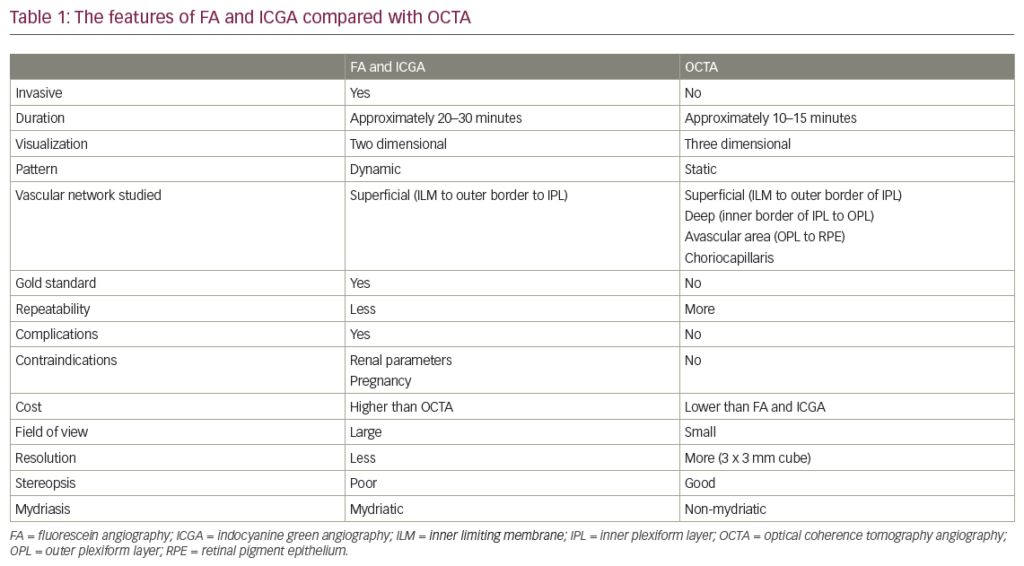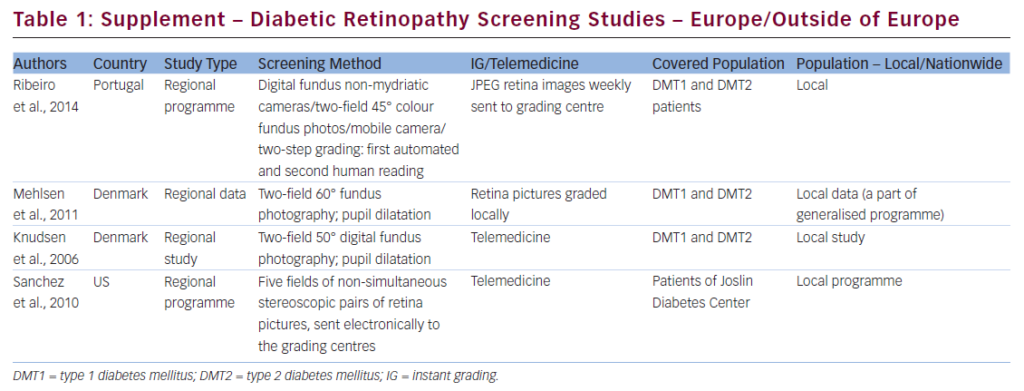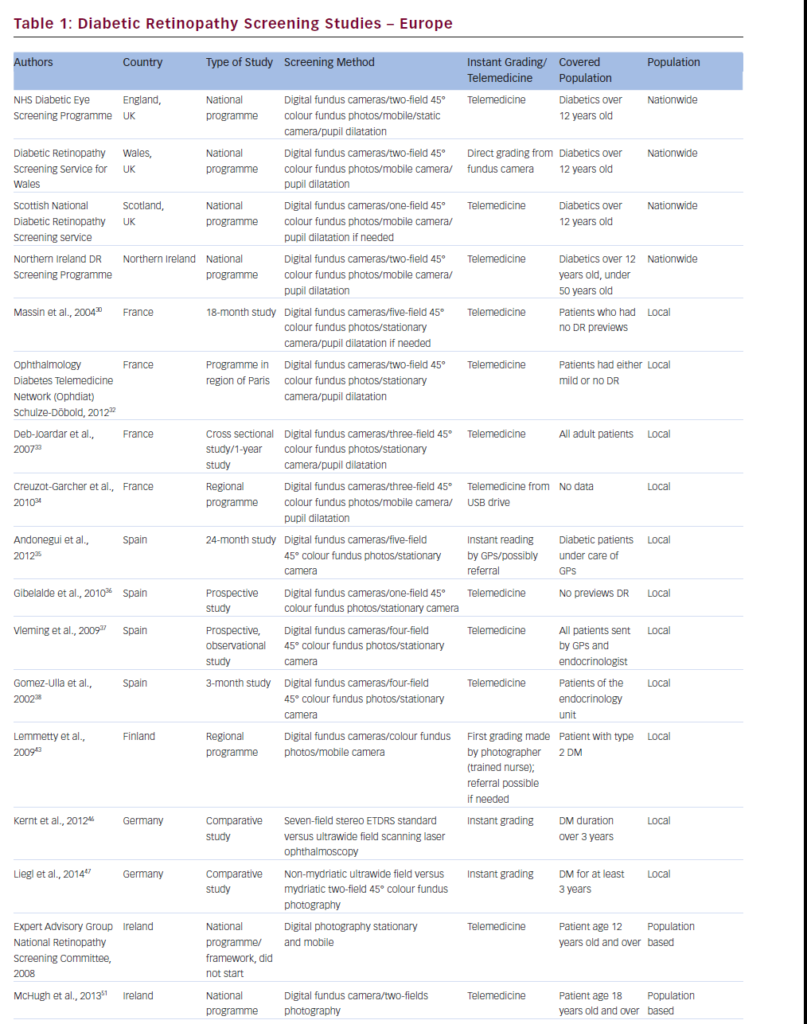Diabetes is a metabolic disease resulting from the body’s insufficient production or use of insulin, a peptide hormone responsible for regulating glucose levels in the blood and tissues. Especially when improperly managed, diabetes results in a number of complications over time, affecting nearly every organ system, including the ocular tissue. In addition to increased risk for glaucoma and cataracts, the most threatening ocular implication of diabetes is diabetic retinopathy, an aggressive disorder historically clinically associated with a variety of retinal microvascular abnormalities. Disease severity is typically classified into two types: nonproliferative diabetic retinopathy (NPDR), marked by microaneurysms, intraretinal hemorrhaging, and other microvascular aberrations, and proliferative diabetic retinopathy (PDR), characterized by the onset of neovascularization and vitreal hemorrhaging.1 Diabetic macular edema (DME), another manifestation of diabetic retinopathy involving macular thickening due to fluid accumulation, is accountable for a great proportion of diabetes-related vision loss.2 While advanced stages of PDR have classically been regarded as the most threatening to sight, visual dysfunction at all stages, even those deemed mild by clinical evaluation, is now apparent. As the leading cause of blindness in US working-age adults,3 diabetic retinopathy has many economic implications for healthcare systems and the overall population,4 as well as a variety of personal consequences on patient quality of life.5,6 However, if addressed early and proactively, the incidence of severe vision loss from diabetic retinopathy can be significantly reduced. This review will discuss the systemic measures necessary for diabetic retinopathy prevention, as well as interventions currently available to delay or stop retinopathy progression once diagnosed. The limitations of present treatment options will also be addressed, as well as current developments in the search for new endpoints and technologies that may allow for earlier detection. Finally, investigations of some of the new therapies and future approaches to diabetic retinopathy research will be reviewed.
Systemic Control and Preventive Intervention
As the prevalence of diabetes worldwide continuously increases, incidence of vision-threatening diabetic retinopathy is projected to nearly triple in the next 40 years.7 For patients diagnosed with diabetes, the most important method of preventing visual complications, such as retinopathy, is to control the diabetes at a systemic level. Tight regulation of glycemia via intensive insulin therapy significantly reduces the risk for retinopathyprevalence and progression.8 In addition to its effect on glycemic and circulating insulin levels, systemic insulin therapy has been shown to have a local impact on ocular tissue as well, including restoration of retinal insulin receptor signaling cascade and rod photoreceptor function.9,10 We recently demonstrated that both components of systemic insulin treatment—normalization of glycemia and insulin signaling, including locally—were critical in restoring normal retinal function.11 Hypertension is another well-known systemic effect of diabetes that can necessitate specific intervention. Indeed while there are conflicting reports on the benefit of antihypertensive therapies alone, combined control of glycemia and blood pressure has been clearly shown to significantly delay the onset and slow the progression of diabetic retinopathy.12–15
Serum lipid levels have also gained recent attention for their potential impact on vision loss in patients with diabetes. Specifically, dyslipidemia and elevated low-density lipoprotein (LDL) have been shown to be significantly associated with retinal hard exudate formation. These factors, along with total cholesterol elevation, are also associated with the occurrence of DME.16,17 A correlation between triglyceride levels and diabetic eye disease has been suggested as well, though its impact on retinopathy specifically is debated.18–20 Further studies are investigating the preventive impact of lipid-lowering agents, such as fibrates and statins, and the first reports have showed a positive impact on reducing diabetic retinopathy onset and progression.21–23 However well achieved, careful regulation of glycemia, blood pressure, and lipid serum levels does not eliminate the potential for vision complications, demonstrating the existence of other risk factors. Different epidemiologic studies have shown that smoking males with type 1 diabetes have a higher prevalence of ocular disease.24,25 An association was also reported between ocular perturbations and previous diagnosis of albuminuria or diabetic nephropathy.26,27 Additional risk factors include puberty, pregnancy, and, most obviously, duration of disease.28,29 Therefore consistent screening is necessary for early detection. It is recommended for type 1 patients with diabetes to receive a comprehensive ophthalmic examination 3 to 5 years after diagnosis, while type 2 diabetics should begin being monitored immediately after diagnosis. Women trying to conceive should have an additional exam prior to conception and during the first trimester.30 Continued dilated eye examinations are recommended annually for asymptomatic patients, with suggested follow-up frequency increasing with diabetes duration and symptom severity.3
Current Therapies
Surgical
The standard of care for patients with high-risk PDR remains panretinal (scatter) photocoagulation surgery, administered in effort to halt neovascularization and prevent hemorrhaging. Scatter laser treatment is also an option to slow progression of retinopathy and subsequent vision loss in select patients with non-high-risk PDR and even severe NPDR; however, side effects such as loss of peripheral and night vision often deem the treatment at this level less favorable.30,31 When clinically significant DME is present, focal photocoagulation surgery is recommended, preferably before pan-retinal treatment if both are required.30 While laser treatment does not restore vision already lost, the damage it inflicts is in preference over that which would occur if retinopathy continued to progress. In advanced cases where laser treatment is either not recommended or insufficient, vitrectomy is an option to address hemorrhaging, as well as to correct retinal detachment and scarring. Vitreous surgery has proved to be a useful therapy for both severe PDR and DME,32,33 and drastic improvement of quality of life has been reported in both cases.6 Supplementing the procedure with epiretinal membrane removal can also increase visual acuity in patients with scarred retinal tissue,34 and peeling of the inner limiting membrane may yield similar visual and anatomical improvements in patients with DME.35,36
Pharmaceutical
In addition to surgical procedures, there are two major classes of locally administered pharmacotherapy available to manage diabetic retinopathy: molecular target agents and synthetic corticosteroids. While molecular target agents aim at controlling one or more of the many pathways involved in the pathogenesis of diabetic retinopathy, corticosteroids are primarily used for their anti-inflammatory function.
At this time, the leaders in the area of molecular target agents are inhibitors of vascular endothelial growth factor (VEGF), a factor known to be involved in angiogenesis and increased permeability of the blood–retinal barrier, contributing to both PDR and DME.37,38 Intravitreal injections of anti-VEGF agents are thus novel therapies for the reduction of neovascularization and vessel leakage, and its efficacy has been well demonstrated in both clinical trials and practice.37,39,40 Combination treatment supplementing pan-retinal photocoagulation with anti-VEGF injections has consistently demonstrated greater vascularization regression and leakage reduction than laser treatment alone.41,42 In fact, comparative studies even suggest that the efficacy of injection-only treatment surpasses that of the more damaging laser option in patients with DME.43,44 There are a number of molecular agents under investigation that act to inhibit VEGF in different ways, including full and fragmented antibodies, small interfering RNAs (siRNAs), and recombinant fusion proteins, although most remain in developmental or trial phases.37 While agents acting on VEGF by alternative mechanisms may prove more robust once implemented in practice, the efficacy of the anti-VEGF therapies available to patients is limited, primarily restricted to the treatment of DME and even then with a variable success rate of 30–50 %.45,46
In addition to molecular target agents, the second class of medical treatment involves injection of synthetic corticosteroids, namely intravitreal triamcinolone acetonide (IVTA). Historically utilized for their anti-inflammatory effects, corticosteroids seem to act by many mechanisms in the retina, and ocular administration has been associated with a variety of benefits for diabetic retinopathy. By inhibiting prostaglandin production, IVTA also suppresses VEGF along with various other cytokines suspected to be involved in the pathogenesis of DME, proving to be a more effective treatment than strictly anti-VEGF agents.47–49 Most recent studies are now suggesting a neuroprotective function of corticosteroids as well, specifically by demonstrating antiapoptotic effects in retinal neurons under diabetic conditions.50 The restorative effects of IVTA are also notably longer lasting than anti-VEGF therapies, thus requiring less frequent treatment and lowering the risk for injection-associated complications such as endophthalmitis and retinal detachment over time.49,51,52
However, while anti-VEGF therapy appears relatively void of short-term side effects, the incidence of complications from corticosteroid injection is high. The most common of those observed are intraocular pressure elevation and cataract formation,53,54 both of which must be monitored for and promptly addressed to avoid subsequent vision loss. Although clinical trials have deemed anti-VEGF therapies safe and with low indication of serious side effects, long-term effects have yet to be reported. Recent attention has been given to VEGF’s important natural role in retinal function and the dangers of its continued antagonism.55,56 Because of their relatively recent implication, additional research is necessary to confirm the ultimate safety of evolving medical therapies, and their risks are important to consider when assessing treatment options.
Research for Improved Therapies
Novel Endpoints
While research continues for the development of new treatment options, optimization of screening techniques is critical for prevention of vision loss. Timely intervention at specific phases in retinopathy progression remains most effective in preserving vision and delaying progression to irreversibly damaging stages. In the past, these stages were classified by the Early Treatment Diabetic Retinopathy Study (ETDRS) severity scale, which grades disease severity based on patient fundus photographs. However, the scale is largely outdated and proving insufficient in accommodating new advancements in disease detection.3 A simpler classification system has since been developed that refines disease pathology to five main stages: no apparent retinopathy; mild NPDR; moderate NPDR; severe NPDR; and PDR.1 These stages, like in the ETDRS severity scale, are defined by the observation of vascular abnormalities such as microaneurysms, hemorrhaging, and neovascularization. Automated grading of these criterion has been a long-standing goal for screening efficiency, but despite recent advances,57 remains to be achieved. The advent of digital fundus cameras has made manual screening for visible indicators more accessible; however, diabetic retinopathy causes changes not only in retinal vasculature but also in the neuronal network as well.58–60 It is now established that the retina exhibits important morphologic and functional changes even before vascular lesions are evident.61 Optical coherence tomography (OCT) can be used to detect relatively severe loss of neuroglia in the nerve fiber layer,62 as well as early development of edema by measuring retinal thickness in clinically asymptomatic patients.63,64 Magnetic resonance imaging (MRI) may also be an effective screening method for early diagnosis by detecting subtle structural changes in the blood–retinal barrier.65,66 Most recently, however, attention is being shifted to the physiologic indicators of diabetic retinopathy. Since apparent structural changes indicate that fairly substantial perturbation of the retina has already occurred, antecedent endpoints or more sensitive detection methods must be identified to allow for earlier, more effective intervention. Ongoing studies using multifocal electroretinogram (mfERG) technology are revealing that measurable functional changes exist in patients with diabetes with no classic indicators of retinopathy,67,68 and suggest that these changes occur before the initiation of morphological changes.69 The measure of local ERG implicit time delay using mfERG is now being investigated for application as a quick and sensitive screening tool, due to its ability to not only predict patient risk for developing retinopathy, but also to locally pinpoint potential problem areas in the retina. As sites exhibiting neuronal dysfunction have been correlated with those that later develop vascular abnormalities and eventually threaten vision,70 mfERG technology may provide an informed method to quantify the risk for disease and the course of its progression. Models considering mfERG results along with other factors, such as patient glucose levels, have been extremely successful in the prognosis of patients with diabetes both with and without retinopathy at baseline.71–73 Most recently, tests of visual fields have also been reported to be more indicative of functional deficiency than visual acuity tests when determining retinopathy severity.74 Frequency doubling technology (FDT) perimetry is now being used to investigate the neuronal consequences of early diabetic retinopathy by testing the visual field. Studies applying the technology have revealed severe impairment of retinal function, particularly affecting the inner retina and rod photoreceptors, even before visual acuity decline.75 The ability to detect these impairments has ignited promising investigations of FDT application as a screening tool for sight-threatening retinopathy,76,77 as well as its use in studying early disease pathogenesis.
Novel Targets/Treatments
While new screening methods may allow for earlier detection of diabetic retinopathy onset, the need for subsequent therapies remains evident. Drugs currently available primarily target late stages of the disease when vision has already been significantly and often irreversibly affected. As the intricate mechanisms underlying retinopathy onset and progression become more understood, new molecular targets are being identified that may prove therapeutic due to their involvement in a variety of pathways, including those instigating vascular modeling, inflammatory response, and neuroprotective mechanisms.
Although VEGF is an established molecular target contributing to microvascular abnormalities, anti-VEGF drugs are only indicated and efficient in a relatively small subset of diabetic retinopathy patients. Both classical and atypical protein kinase C (PKC) have been identified as required components of pathways involving VEGF and associated factors, controlling the permeability of the blood–retinal barrier and other vascular alterations.78–80 Inhibitors of PKC isoforms have long been considered and remain under investigation as more effective therapies to delay or reduce the damaging vascular consequences of developing diabetic retinopathy.81–82 Pro-inflammatory pathways have also been demonstrated to be instrumental in blood–retinal barrier breakdown, apoptosis of vascular endothelial cells, and retinal leukostasis, collectively contributing to lesions, vessel leakage, and, ultimately, vision loss.83–85 Inhibition of a variety of major mediators involved in inflammatory responses, such as tumor necrosis factor alpha (TNFα),86,87 cyclooxygenase (COX-2),88 nuclear factor-kappaB (NFκB),89 and its proposed cofactor poly(ADP-ribose) polymerase (PARP)90 has proved the therapeutic benefit of anti-inflammatory drugs in delaying diabetes-associated retinal vascular complications.
The relatively recent recognition of diabetic retinopathy as both a structural and functional disease has drawn increasing attention to the neuronal aspects of diabetes-related retinal damage, which may ultimately contribute to therapies more preventive in nature. Neurodegeneration, a prominent feature of early disease development and large contributor to subsequent vision loss, has been shown to result from a variety of factors instigated by diabetes pathology, such as oxidative stress91,92 and improper retinal activation of the renin-angiotensin system (RAS).92,93 Pathways provoked by reactive oxygen species (ROS) impact the neuroglia that, in turn, evokes vascular consequences. Disruption of these pathways by inhibiting important mediators such as advanced glycation endproducts (AGEs) and their receptors have demonstrated protective effects against vision loss.94–96 Similarly, studies investigating the blockade of the RAS via associated target agents including angiotensin converting enzyme (ACE) inhibitors and angiotensin receptor blockers (ARBs) have shown positive effects in reducing diabetic retinopathy progression.97,98
Also important to the pathogenesis of diabetic retinopathy is the progressive disruption of intrinsic protective mechanisms. The next generation of retinopathy research is uncovering the reduction or dysfunction of several agents that, under normal conditions, serve neuroprotective and reparative roles. Pigment epithelial derived factor (PEDF), for example, is a multifunctional protein typically operating as a neuroprotective, antioxidative, and anti-inflammatory agent, but its levels are substantially decreased in early diabetic retinopathy.99,100 Conversely, levels of ocular crystallins and other heat shock proteins (HSPs) that normally elicit neuroprotective responses in stress conditions have been shown to be overexpressed in the diabetic retina; however, their protective functions are impaired.101–103 Erythropoietin (EPO) is another agent proved imperative for retinal cell survival and compensatory mechanisms in response to early neuronal damage in retinopathy; however, its upregulation in advanced stages of disease development can alternately contribute to neovascularization and worsen PDR.104 Studies are underway to further characterize the therapeutic potential of these natural protective agents, either in their native or slightly modified form, in early stages of diabetic retinopathy.105–109
Conclusions
Diabetic retinopathy is a complex neurovascular disorder that may threaten vision in all patients with diabetes. A proactive, multidisciplinary approach can help significantly reduce the risk for vision loss from diabetes and associated eye disease such as diabetic retinopathy. While the intricate mechanisms contributing to disease pathogenesis continue to be elucidated, future research should be integrative in nature, addressing both systemic and ocular factors as they contribute to vision impairment in diabetes.









